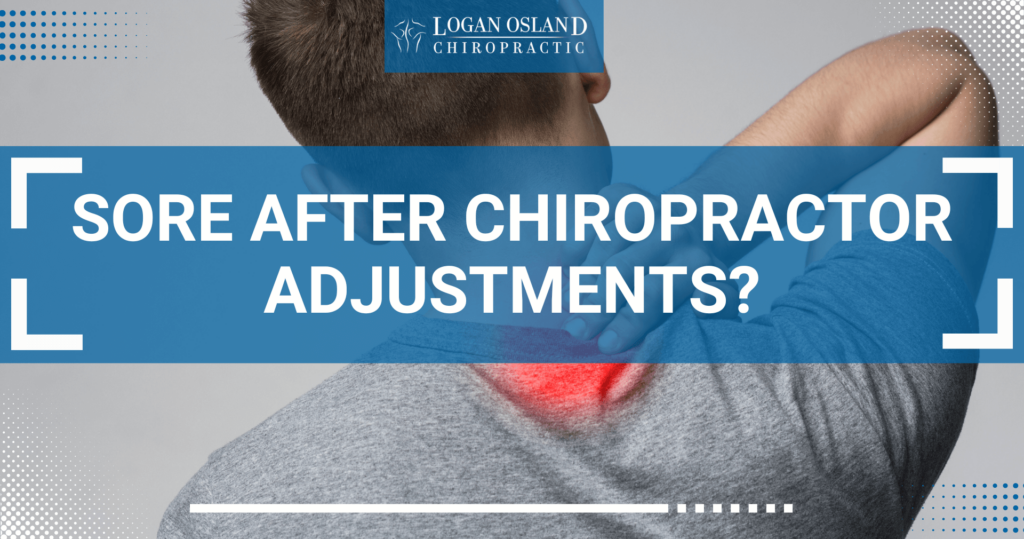You are not alone if you feel stiff after a recent chiropractic visit. Feeling sore after chiropractor adjustments can be disheartening, but there are proven techniques to ease this discomfort and enhance the healing process. It means you can enjoy the benefits of your treatment without the pain.
Soreness after adjustments results from the body adjusting to chiropractic manipulation and can vary in intensity. Understanding this process will help you manage discomfort and enhance the benefits of your chiropractic care.
This article covers post-adjustment soreness, including common areas and how to differentiate between normal soreness and severe pain. You will also learn various techniques to help you relieve the pain and feel more comfortable. So let’s get into it.
Understanding Post-Adjustment Soreness
During adjustment, the chiropractor moves your vertebrae, stretching and stimulating muscles. Just like after exercising, your muscles may feel sore as they adapt to these changes. It is completely normal and usually lasts for a short time.
However, some people may experience different reactions after their sessions, such as feeling dizzy after a chiropractic appointment. Understanding what to do after a chiropractic adjustment can help manage both dizziness and soreness, ensuring a smoother recovery. Feeling dizzy is a common response that might occur due to the body’s adjustments and is usually temporary.
Common Areas of Soreness
Areas of soreness may vary depending on your situation and the level of your adjustments. Common body areas of soreness after a chiropractic session include the lower back, neck, shoulders, and hips. Let’s examine each point and understand why each area gets sore after the session.
- Lower back pain occurs due to realignment of the spine, causing the muscles to stretch and adapt.
- Neck pain usually results from neck adjustment, which may irritate surrounding muscles not used to that movement.
- Shoulder pain may arise as the chiropractor works on the upper spine, impacting the shoulder muscles and joints.
- Hip pain occurs when the adjustment affects the pelvis, leading to temporary discomfort as your body muscles adapt to the adjusted position.
Normal Soreness Vs. Severe Pain
As mentioned, you may feel mild soreness after a chiropractic adjustment as your body muscles adapt to the new changes. However, distinguishing between mild soreness and chronic pain is crucial.
You must know when to visit your doctor to avoid any unwanted circumstances. Now, the question is: How can you tell between mild soreness and severe pain? Severe pain can be alarming and may indicate a problem that needs attention.
If you experience symptoms like sharp leg pain, shooting pain, numbness, or tingling, you must take those seriously. These could be nerve irritation or injury signs that might require further evaluation.
If your soreness intensifies or chiropractic adjustments hurt more than expected, it is wise to consult a doctor. Trust your body; don’t hesitate to seek help if something feels off. Your health and safety must always come first.
In some cases, patients might also experience feeling sharp back pain after a chiropractor session. This can happen as your muscles adjust to the new alignment. If the pain is sharp or continues for several days, it’s important to reach out to your chiropractor.
Reasons for Post-Adjustment Soreness
Here are some common reasons for experiencing soreness after a chiropractic session:
Muscle Tension Release
- During a spinal adjustment, the chiropractor applies controlled force to the joints, which releases built-up muscle tension and trigger points.
- As the muscles relax and release tension, it leads to soreness or discomfort in the affected areas.
Joint Mobilization
- Chiropractic adjustments involve the gentle manipulation of the joints, particularly the spinal joints.
- This mobilization causes temporary discomfort as the joints move in ways they may not be accustomed to.
- Soreness is often a result of the body adapting to a new range of motion, joint positioning, or muscle development.
Inflammation Reduction
- Chiropractic adjustments can help reduce inflammation in the joints and surrounding tissues.
- As the inflammation decreases, the body can temporarily experience increased discomfort as it adjusts to the reduced swelling.
- This soreness is often a positive sign that the adjustment is working to improve joint function and reduce inflammation.
Nerve Stimulation
- Spinal adjustments can stimulate the nerves that run through the spine and into the surrounding muscles.
- This stimulation can cause temporary soreness or discomfort as the nerves respond to the adjustment.
- The soreness is often a result of the nerves adjusting to the new input and can be a sign that the adjustment has a positive effect on the nervous system.
Detoxification
- Chiropractic adjustments help the body detoxify by improving circulation and lymphatic drainage.
- The body’s elimination of toxins and waste products causes temporary soreness or discomfort.
- This soreness is often a sign that the body is responding positively to the adjustment and is working to improve overall health and well-being.
How to Manage Post-Adjustment Soreness?
Managing post-adjustment soreness improves recovery and overall comfort. If you feel sore muscles or stiff joints after the chiropractic treatment, here are a few steps to relieve your pain and make you feel comfortable.
Stay Hydrated
Hydration is the key to recovery after a spinal adjustment. Water plays a critical one in maintaining the health of your muscles and joints. When you drink water, your body flushes out toxins and supports the healing process. So:
- Drink plenty of water. Aim for at least eight glasses per day. If you’ve just undergone treatment, consider increasing your intake slightly.
- Adding electrolytes may enhance hydration. Consider drinks that replenish essential minerals without added sugars.
- If you feel thirsty, don’t ignore it. Staying hydrated helps alleviate pain and promotes overall wellness.
Apply Ice or Heat
Ice or heat massage is perfect for pain relief and quick recovery. It eases discomfort whether you have hit the gym or are coming from a deep chiro adjustment session. Here are a few things to know:
- If you’re experiencing swelling or acute pain, apply an ice pack to the affected areas for 15-20 minutes. It’ll reduce inflammation and numb the soreness.
- As the initial soreness subsides, switch to heat after a while. A warm compress or heating pad will relax tight muscles and improve blood flow.
- Some people prefer alternating between ice and heat. It can stimulate circulation and promote healing.
Gentle Stretching and Movement.
Incorporating gentle stretching and movement can significantly aid recovery and reduce muscle tension. Begin with light stretches focusing on the areas where you feel soreness. Simple neck rolls or shoulder shrugs can be effective.
If you have access to physical therapy resources, consider using them. These techniques can help strengthen muscles and improve flexibility. Pay attention to how your body responds. If a stretch feels painful, ease off and try a gentler movement.
Take a Good Rest
Allow your understimulated muscles to rest appropriately. It will help your body manage temporary soreness. Get quality sleep. Aim for 7-9 hours of restful sleep each night to reduce muscle soreness and heal your body.
Deep breathing, meditation, or gentle yoga reduce stress and promote relaxation. These activities can alleviate mild discomfort and enhance your overall sense of well-being. For a few days after the chiropractic visit, avoid high-impact exercises or heavy lifting. This will give your body enough time to adapt and recover.
Last Minute Thoughts!
Experiencing soreness after a chiropractic adjustment is normal and typically a sign that your body responds positively to the treatment. To manage this temporary discomfort, remember to stay hydrated, use ice or heat, stretch gently, and rest well.
Don’t hesitate to seek professional advice if you have any concerns or if the pain persists. For top-notch chiropractic care, trust Dr. Logan Osland at Dr. Osland Chiropractic. They provide expert, compassionate care tailored to your needs. Schedule your appointment today and take the first step towards a pain-free life!


